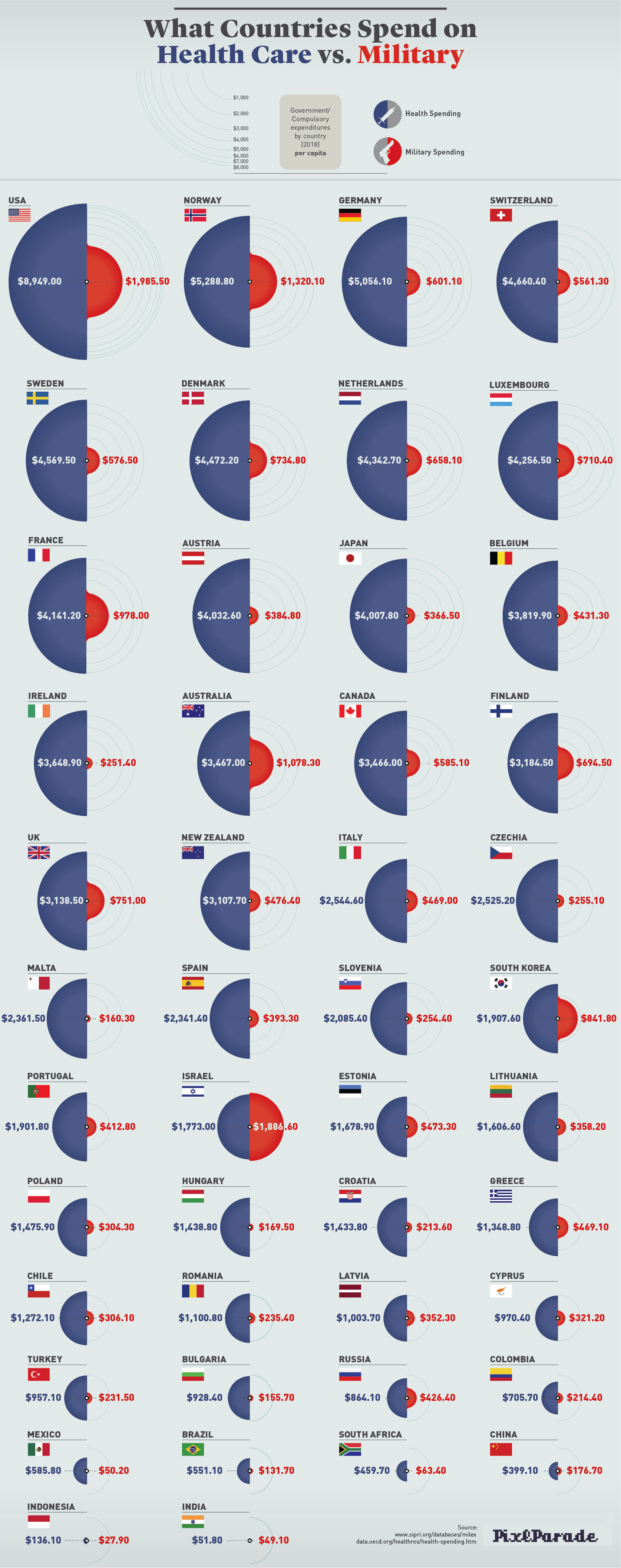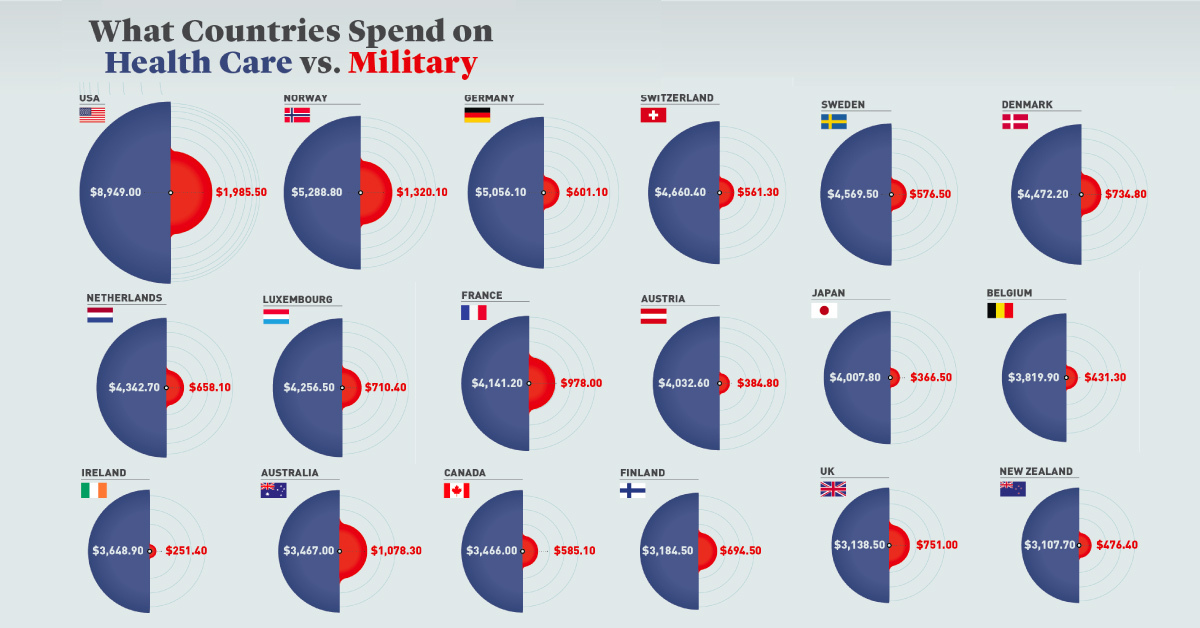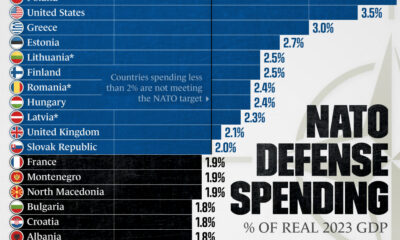Politics
How Much Do Countries Spend on Healthcare Compared to the Military?

Healthcare vs. Military Spending, by Country
Keeping citizens both healthy and secure are key priorities for many national governments around the world—but ultimately, decisions must be made on how tax dollars are spent to accomplish these objectives, and funding must fall into one bucket or another.
This infographic from PixlParade examines how much 46 different countries put towards healthcare and military spending in 2018, per capita.
Head to Head: Healthcare versus Military
Data for government and compulsory healthcare spending comes from the Organization for Economic Co-operation and Development (OECD). Note that these figures do not include spending through private insurance or out-of-pocket expenses.
Meanwhile, the data for military spending comes from the Stockholm International Peace Research Institute (SIPRI).
| Country | Health spending (Per capita, 2018 US$) | Military spending (Per capita, 2018 US$) |
|---|---|---|
| U.S. | $9,008.77 | $2,086.50 |
| Norway | $5,361.00 | $1,323.90 |
| Germany | $5,262.83 | $559.50 |
| Switzerland | $4,687.26 | $546.00 |
| Sweden | $4,623.68 | $574.90 |
| Netherlands | $4,461.30 | $651.50 |
| Denmark | $4,441.07 | $792.50 |
| Luxembourg | $4,385.66 | $650.80 |
| France | $4,310.55 | $791.00 |
| Austria | $4,137.25 | $381.00 |
| Belgium | $3,868.82 | $421.60 |
| Japan | $3,787.74 | $366.50 |
| Canada | $3,719.86 | $613.10 |
| Ireland | $3,629.43 | $229.80 |
| UK | $3,336.55 | $743.10 |
| Finland | $3,331.65 | $680.30 |
| Australia | $3,311.33 | $1,078.00 |
| NZ | $3,188.39 | $532.30 |
| Czhechia | $2,632.67 | $254.10 |
| Italy | $2,574.96 | $458.70 |
| Malta | $2,448.73 | $152.20 |
| Spain | $2,414.69 | $381.70 |
| Slovenia | $2,227.77 | $254.80 |
| Portugal | $1,906.23 | $431.00 |
| South Korea | $1,848.76 | $841.70 |
| Israel | $1,828.40 | $2,357.50 |
| Estonia | $1,744.57 | $458.60 |
| Lithuania | $1,599.15 | $377.10 |
| Croatia | $1,553.67 | $232.50 |
| Poland | $1,511.18 | $317.50 |
| Hungary | $1,493.01 | $184.60 |
| Romania | $1,344.34 | $223.50 |
| Greece | $1,331.19 | $547.10 |
| Chile | $1,282.59 | $296.10 |
| Latvia | $1,111.67 | $375.20 |
| Cyprus | $1,103.03 | $374.30 |
| Bulgaria | $1,042.85 | $136.30 |
| Turkey | $946.83 | $238.60 |
| Russia | $873.00 | $421.20 |
| Colombia | $864.16 | $204.10 |
| Mexico | $582.05 | $46.30 |
| Brazil | $388.98 | $134.50 |
| South Africa | $267.85 | $63.50 |
| China | $249.83 | $177.60 |
| Indonesia | $55.62 | $28.20 |
| India | $18.80 | $49.00 |
| Source: OECD | Source: SIPRI |
Note: There are minor discrepancies in comparing table data to original sources due to recent estimate updates. Figures for Brazil, South Africa, China, Indonesia, and India come from the World Bank (2017).
The Top 10 Healthcare Spenders
The U.S. leads the world in government healthcare spending at $9,008 per capita – over 1.5 times that of Norway, the next-highest country examined.
| Country | Per capita health spending | % of GDP | % of health spending |
|---|---|---|---|
| U.S. | $9,008.77 | 14.3% | 84.7% |
| Norway | $5,361.00 | 8.6% | 85.3% |
| Germany | $5,262.83 | 9.7% | 84.6% |
| Switzerland | $4,687.26 | 7.6% | 64.4% |
| Sweden | $4,623.68 | 9.3% | 85.1% |
| Netherlands | $4,461.30 | 8.2% | 82.1% |
| Denmark | $4,441.07 | 8.5% | 83.9% |
| Luxembourg | $4,385.66 | 4.4% | 84.1% |
| France | $4,310.55 | 9.4% | 83.6% |
| Austria | $4,137.25 | 7.7% | 74.7% |
While per-capita government spending on healthcare in the U.S. is the highest in the world, this has not necessarily brought about better outcomes (such as longer life expectancy) compared to other developed nations.
It’s also worth mentioning that the above figures do not cover all healthcare costs incurred by citizens, as they do not account for private insurance spending or out-of-pocket expenses. According to OECD data, these additional costs tend to be the highest in places like Switzerland and the United States.
The Top 10 Military Spenders
Israel has the highest rate of military spending per capita, and has the distinction of being the only country on this list to invest more in defense than in healthcare.
| Country | Per capita military spending | % of GDP | Total expenditure, US$M |
|---|---|---|---|
| Israel | $2,357.50 | 5.3% | $19,759M |
| U.S. | $2,086.50 | 3.3% | $682,491M |
| Norway | $1,323.90 | 1.6% | $7,067M |
| Australia | $1,078.00 | 1.9% | $26,840M |
| South Korea | $841.70 | 2.5% | $43,070M |
| Denmark | $792.50 | 1.3% | $4,559M |
| France | $791.00 | 1.3% | $51,410M |
| UK | $743.10 | 1.8% | $49,892M |
| Finland | $680.30 | 1.4% | $3,757M |
| Netherlands | $651.50 | 1.2% | $11,115M |
Although the United States comes in second place here as well, in absolute terms, the U.S. puts more money into military expenditures than many other countries combined, at almost $700 billion per year.
United States
Charted: What Southeast Asia Thinks About China & the U.S.
A significant share of respondents from an ASEAN-focused survey are not happy about rising American and Chinese influence in the region.

What Southeast Asia Thinks About China & the U.S.
This was originally posted on our Voronoi app. Download the app for free on iOS or Android and discover incredible data-driven charts from a variety of trusted sources.
This chart visualizes the results of a 2024 survey conducted by the ASEAN Studies Centre at the ISEAS-Yusof Ishak Institute. Nearly 2,000 respondents were asked if they were worried or welcoming of rising Chinese and American geopolitical influence in their country.
The countries surveyed all belong to the Association of Southeast Asian Nations (ASEAN), a political and economic union of 10 states in Southeast Asia.
Feelings Towards China
On average, a significant share of respondents from all 10 countries are worried about rising influence from both the U.S. and China.
However, overall skepticism is higher for China, at 74% (versus 59% for U.S.).
| Country | Worried About Growing 🇨🇳 Influence | Welcome Growing 🇨🇳 Influence |
|---|---|---|
| 🇧🇳 Brunei | 58% | 42% |
| 🇰🇭 Cambodia | 66% | 34% |
| 🇮🇩 Indonesia | 57% | 43% |
| 🇱🇦 Laos | 68% | 32% |
| 🇲🇾 Malaysia | 56% | 44% |
| 🇲🇲 Myanmar | 95% | 5% |
| 🇵🇭 Philippines | 81% | 19% |
| 🇸🇬 Singapore | 74% | 26% |
| 🇹🇭 Thailand | 84% | 16% |
| 🇻🇳 Vietnam | 96% | 4% |
| Average | 74% | 27% |
The recently-cooled but still active territorial concerns over the South China Sea may play a significant role in these responses, especially in countries which are also claimants over the sea.
For example, in Vietnam over 95% of respondents said they were worried about China’s growing influence.
Feelings Towards America
Conversely, rising American influence is welcomed in two countries with competing claims in the South China Sea, the Philippines (69%) and Vietnam (55%).
| Country | Worried About Growing 🇺🇸 Influence | Welcome Growing 🇺🇸 Influence |
|---|---|---|
| 🇧🇳 Brunei | 73% | 27% |
| 🇰🇭 Cambodia | 58% | 42% |
| 🇮🇩 Indonesia | 73% | 27% |
| 🇱🇦 Laos | 79% | 21% |
| 🇲🇾 Malaysia | 68% | 32% |
| 🇲🇲 Myanmar | 45% | 55% |
| 🇵🇭 Philippines | 32% | 69% |
| 🇸🇬 Singapore | 37% | 63% |
| 🇹🇭 Thailand | 80% | 20% |
| 🇻🇳 Vietnam | 45% | 55% |
| Average | 59% | 41% |
Despite this, on a regional average, more respondents worry about growing American influence (59%) than they welcome it (41%).
Interestingly, it seems almost every ASEAN nation has a clear preference for one superpower over the other.
The only exception is Thailand, where those surveyed were not a fan of either option, with 84% worried about China, and 80% worried about the U.S.
-

 Energy6 days ago
Energy6 days agoMapped: The Age of Energy Projects in Interconnection Queues, by State
-

 AI2 weeks ago
AI2 weeks agoVisualizing AI Patents by Country
-

 Markets2 weeks ago
Markets2 weeks agoEconomic Growth Forecasts for G7 and BRICS Countries in 2024
-

 Wealth2 weeks ago
Wealth2 weeks agoCharted: Which City Has the Most Billionaires in 2024?
-

 Technology1 week ago
Technology1 week agoAll of the Grants Given by the U.S. CHIPS Act
-

 Green1 week ago
Green1 week agoThe Carbon Footprint of Major Travel Methods
-

 United States1 week ago
United States1 week agoVisualizing the Most Common Pets in the U.S.
-

 Culture1 week ago
Culture1 week agoThe World’s Top Media Franchises by All-Time Revenue















